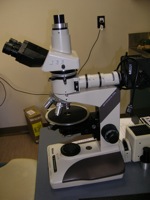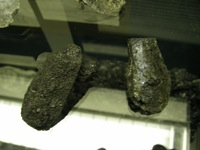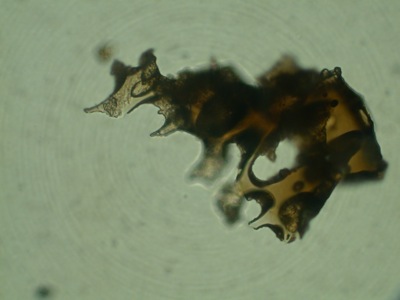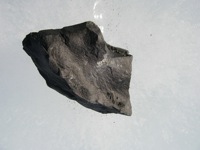> see also Photogallery n°19 and video dedicated to the group at Project Iceberg
Massimo Pompilio (INGV – National Institute of Geophysics and Volcanology – Rome -Italy)
Phil Kyle (New Mexico Institute of Mining & Technology – New Mexico – USA)
Gerhard Kuhn (Alfred Wegener Institute – Bremerhaven – Germania)
Petrology studies rocks and rock components (minerals, glass). Since there are three rock macrofamilies (igneous, metamorphic, and sedimentary), there are also three different branches of petrography: igneous, metamorphic, and sedimentary.
What’s analysed?
Rocks and clasts (stones) recovered are analysed for their chemical & mineralogical composition.
Which analyses are carried out?
The analyses carried out on-ice, i.e. here in Mc Murdo’s laboratory, are conventional ones- the observation of thin sections of the different rock types under the petrographic microscope.
Afterwards (off-ice), in the laboratories of various Universities, more detailed analyses are carried out on the rocks, especially those needing to be studied with more precision and accuracy; it is possible to define their mineralogical, chemical, and even isotopic composition.
How are the analyses carried out?
The petrographic analyses conducted on-site, here in Mc Murdo’s laboratory consist mainly of two types:
Stereomicroscope observation. The sample is observed as it is, magnified up to 500 times in reflected light (the stereomicroscope is very similar to a very powerful common magnifying glass).
Petrographic microscope observation. The sample is observed by means of a special microscope for petrography, after preparing a slice thin enough for light to pass through it (observation in transmitted light), and a magnification factor of 1200X using an oil immersion objective lens.
OBSERVATION UNDER A STEREOMICROSCOPE
On the loose, little lithified rocks, clasts of different sizes (even a fraction of a mm) are separated and their details observed (size and also shape might yield important information).
OBSERVATION UNDER A PETROGRAPHIC MICROSCOPE
 A stone is opaque to the passage of light, but if a section thin enough is cut, then light is able to pass through it. This kind of slice is called a thin section.
A stone is opaque to the passage of light, but if a section thin enough is cut, then light is able to pass through it. This kind of slice is called a thin section.
How do we prepare a thin section of rock? You can see and read about it in photogallery n°19. The main steps of the sample preparation are as follows:
Raw cutting of the rock into coarse sections about 5 mm thick
Surface rubbing and smoothing
Mounting of coarse section onto a slide and fixing
Thin cutting of section (glued to the slide) to 1 mm-thick segments
Final smoothing to obtain a 30 micron-thick section (0.03 mm)
The sample is then observed by means of a special microscope called petrographic microscope that is similar to the common light microscope used for biological specimens, but with a small difference; it is equipped with some filters (polarizers) placed between the light source and the sample, and between the sample and the objective. With these filters, it is possible to identify the minerals in the rock according to their different optical properties.
What is found out?
Knowledge of the rocks, and minerals that make up the rocks, may give us extremely useful hints for the reconstruction (along with all the other information collected) of a coherent overall interpretation of the geology of the area. The petrographic indications (i.e. “In rock Z, minerals X and Y are found”) must be consistent with the temporal-stratigraphic indications (i.e. “When did Z appear in the area? Which stratigraphic units can be found above/afterwards or below/before?”) and the sedimentological-spatial indications (i.e. “Where were minerals X and Y formed? How did minerals Z, X and Y reach the area?”).
 The ANDRILL drilling area for example is quite an active volcanic area, currently dominated by Erebus (see also section “The choice of the site”); the history of this volcano is very important for the ANDRILL research for dating purposes as well. Unfortunately, the history of the Erebus is little known because ice covers its slopes and reduces the number of rocky outcrops for study (less than 5%). A distinct character of the lava emitted by Erebus is the presence of Anortose crystals (see photo on the right), a mineral that is found in large crystals and is considered a ‘fingerprint’ of this volcano’s lava (these crystals are found only here and on Mount Kenya, Africa). Furthermore, during lava cooling these crystals are orientated according to the direction of the lava flow.
The ANDRILL drilling area for example is quite an active volcanic area, currently dominated by Erebus (see also section “The choice of the site”); the history of this volcano is very important for the ANDRILL research for dating purposes as well. Unfortunately, the history of the Erebus is little known because ice covers its slopes and reduces the number of rocky outcrops for study (less than 5%). A distinct character of the lava emitted by Erebus is the presence of Anortose crystals (see photo on the right), a mineral that is found in large crystals and is considered a ‘fingerprint’ of this volcano’s lava (these crystals are found only here and on Mount Kenya, Africa). Furthermore, during lava cooling these crystals are orientated according to the direction of the lava flow.
Microscopic observation of clasts provides additional important indications, which may help to decide if a deposit is of the primary type (formed and immediately settled) or the secondary type (i.e. formed, transported away and then settled, maybe more than once). For instance, clasts with angular shapes suggest they underwent a mild transport phase, which happened soon after their formation; on the other hand, clasts with a round shape suggest they underwent an extended transport phase caused by environmental agents (water and ice).
Case study

Inside the cores collected during the ANDRILL perforation down to 120 m, some units consisting of volcanic deposits were observed: these deposits were made of very fine vitreous clasts (like the one in the picture above), with a vacuolar structure and very sharp angles. They are called Tefra. These are very fine magma droplets sprayed during an eruption and instantly cooled (which explains their vitreous structure). As you may see, they are extremely fragile clasts very unlikely to survive long and intense transport phases. For this reason, the stratigraphic unity where they reside is considered a primary deposition (i.e. formed, immediately settled with little or no transport).
To be able to deduce with a good degree of certainty that a particular layer has not moved ever since its deposition is quite a lucky and rare event (especially if it can be dated), because it represents a precise time reference for all the stratigraphic sequence.
